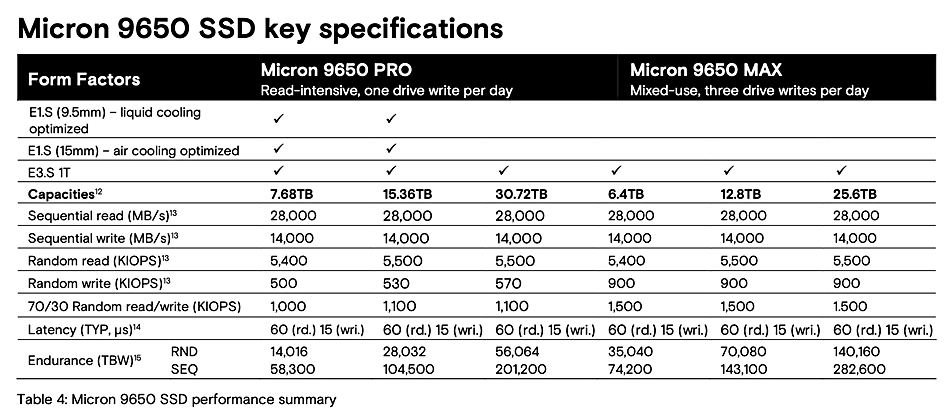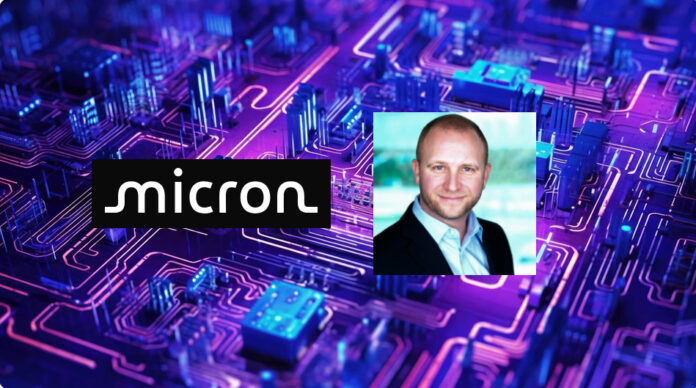Micron has announced three different SSDs aimed at three different markets. The 9650 is a PCIe Gen 6 SSD using TLC (3 bits/cell) flash and built for speed. The 6600 ION is a high-capacity – 122.88 TB – PCIe Gen 5 drive using slower QLC (4 bits/cell) flash. The third drive, the 7600, is another PCIe Gen 5 TLC product designed for consistent low latency in the 1.6-15.36 TB capacity area. All three use its latest Gen 9 276-layer 3D NAND and have Micron’s own DRAM, NAND, controller, and firmware.
9650
This is a PCIe Gen 6 drive, in TLC format using 276-layer Gen 9 Micron NAND, and consequently a fast performer, PCIe 6 being twice the speed of the PCIe 5 interconnect. It comes in a read-optimized – 9650 Pro – or mixed-use variant – 9650 Max – and the performance varies between them:

The headline numbers are 5.5 million/900,000 random read/write IOPS, 28 GBps sequential read and 14 GBps sequential write bandwidth, with Micron saying these speeds can dramatically accelerate AI training and inference. The capacity range is 6.4 TB up to 25.6 TB in E3.S format with the 9650 Max, and 7.68 TB to 30.72 TB in either E1.S or E3.S formats with the 9650 Pro. This also has an E1.S liquid cooling option for the 7.68 and 15.36 TB versions, suggesting they run hot. Parallel IO operations are helped by the 9650 having a six-plane architecture.
The prior Micron 9550 is a PCIe Gen5 SSD built with its earlier Gen 8 232-layer NAND. It delivered up to 3.3 million/900,000 random read/write IOPS and 14/10 GBps sequential read/write bandwidth – substantially slower than the 9650. The 9650 also delivers more MB/watt, being 1.2 to 2x more efficient than the 9550.
The 9650 has lots of security and other certifications: FIPS 140-3 Level 2 and Trade Agreements Act (TAA) compliant options, SPDM 1.2 device security, self-encrypting drive (SED) options, Micron Secure Execution Environment (SEE), FIPS 140-3 Level 2, and TAA compliant options, OCP 2.6.
6600 ION
The 6600 ION succeeds the 6550 ION both in E3.S and U.2 (2.5-inch) formats, plus E1.L for the 6550. They are PCIe Gen5 drives with the 6550 using TLC (3bits/cell) 232-layer 3D NAND and the 6600 built with newer 276-layer NAND but formatted in QLC (4bits/cell). The 6550 comes in 30.72 and 61.44 TB versions whereas the 6600 adds a 122.88 TB option.
The speed differences are telling:
- 6550: 1.6 million/70K random read/write IOPS, 12/5 sequential read/write GBps
- 6600: 2 million/40K random read/write IOPS, 14/3 sequential read/write GBps

Oddly, the 30.72 TB version of the 6600 puts out 100,000 random write IOPS while the 61.44 TB and 122.88 TB variants can only put out 40,000. The 30.72 TB 6600 has a 4 KB Indirection Unit (IU) and there is a 16 KB IU for the larger capacity 6600s. IU entries are stored in DRAM and a larger IU means less DRAM is needed for a set capacity as there are fewer mapping entries.
We understand that a 4KB IU means one mapping entry corresponds to a 4KB logical block, aligning with the typical drive Logical Block Address (LBA) size. A 16KB IU means one mapping entry covers 16KB (e.g., four 4KB LBAs), reducing the number of mapping entries needed but potentially impacting performance and endurance, as it certainly appears to do so here. Writing 4 KB of data to an SSD with a 16 KB IU means reading an entire 16KB page, modifying 4KB, and writing back 16KB, causing write amplification. A 245 TB version of the 6600 is coming later.
7650
Like the 9650, this drive comes in read-intensive Pro and Max mixed-use variants but is only available in the U.2 format. Its capacity range is limited, at 1.6-12.8 TB for the Max and 1.92-15.36 TB for the Pro version, essentially half that of the 9650. The performance is not the fastest, as the table below illustrates:

Micron says the 7650 has “class-leading performance for AI, databases, content delivery, real-time analytics, social media, cloud computing, and virtualization.”
CoreWeave chief product officer Chetan Kapoor said: “The 7600 SSD provides the right balance of affordability, performance and predictable latency for most datacenter workloads including AI.”
Security features include SPDM 1.2 device security, self-encrypting drive (SED) options, Micron Secure Execution Environment (the Micron SEE is a dedicated security processing unit electrically isolated from the other [open] microprocessor(s) inside the SSD controller), FIPS 140-3 Level 2, and TAA compliant options available.
We understand it is a successor to the older PCIe 4-using Micron 7500 Pro and Max drives.
9650 and 7600 SSD samples are shipping to customers now. The 6600 ION 122 TB SSD samples are shipping later in the third quarter of calendar 2025 in E3.S and U.2 form factors. The 245 TB SSD version of the 6600 ION SSD is planned to be available in the first half of calendar 2026.
Get a 9650 product brief here, a 6600 ION brief here, and a 7600 brief here.








